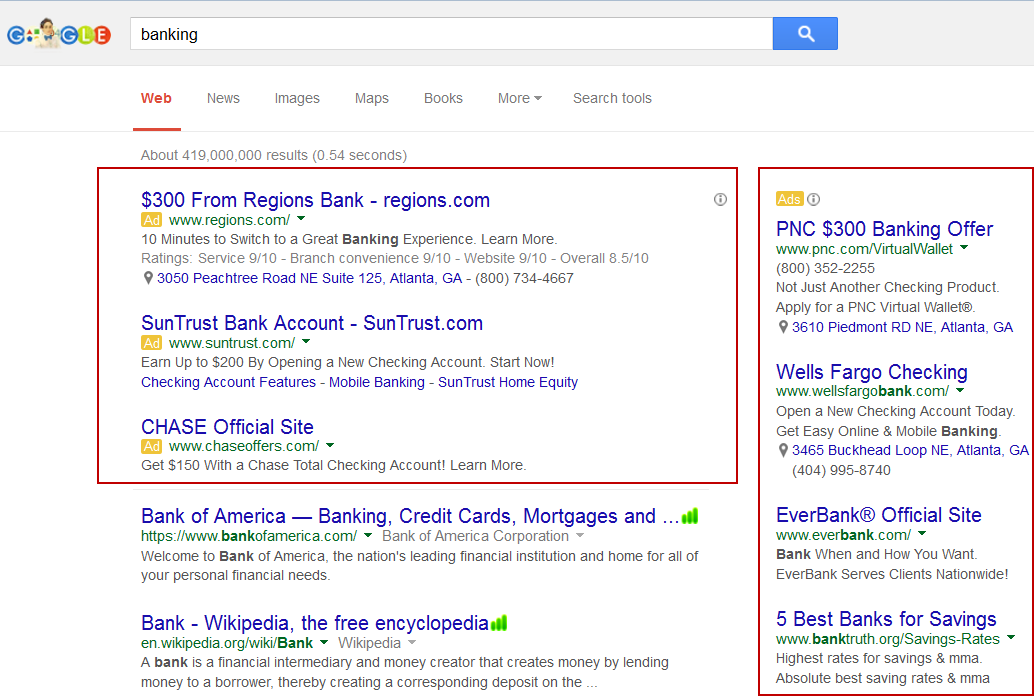Google AdWords 101: Paid Search vs. Remarketing

Google AdWords is probably the best online marketing tool out there for businesses. This blog was written to provide business owners with a basic overview of how it works and how use it.
Before we even talk about setting things up, we must first actually define what Google AdWords is. Google AdWords is an online marketing tool run by the search engine company Google (they’re kind of a big deal—maybe you’ve heard of them). There are two ways to advertise on Google AdWords: paid search and remarketing.
Paid Search
You have the option to purchase advertising based on keywords. Your ad will then show prominently on the search results for someone Google decides is searching for something relevant. Take a look at the picture below showing a Google search for the term “banking.” The paid advertisements are shown in the red boxes. As you can see, paid ads are displayed at the top and down the side of the search engine results page.

How Does Google Determine Which Paid Ad to Show?
Business owners bid on “keywords” that they think would be relevant to their business. Then Google picks the most relevant ads and serves (aka shows) them to a user based on that user’s search request. There may be more than one business bidding on a keyword, so Google uses a formula based on what the bidder is willing to pay and relevancy to the specific search being performed to determine which ad it should serve.
Google determines relevancy by the amount of clicks on an ad. Simply put, the more people that click on an ad based on the keyword search, the more relevant Google thinks that ad is.
Speaking of relevancy: [eBook] Analyzing Google Analytics
The other part of the formula, price, is determined by a multitude of factors. The first factor, like in any auction, is the amount of people bidding on that keyword. The more people bidding, the higher the price will be. As an example, let’s compare the keywords “insurance” and “GoSmallBiz.” Thousands of companies are bidding on the first keyword while only a handful are bidding on the second, so it is much cheaper to purchase paid advertising using the keyword “GoSmallBiz” than it is with the keyword “insurance.”
The second determinate of price is ad relevancy. Google wants to display relevant, engaging content to it’s users, so if Google deems your ad to be more relevant than others bidding on that same keyword or set of keywords, they will give you a discount on the price. If Google does not think your ad is relevant to the keywords you are bidding on, you will have to pay more than the average bid price for that keyword.
Remarketing
Remarketing ads are based on a user’s search history. You tell Google which people you want them to track, and then those designated people are served your ads. Let’s break it down using the fictional cookie company ABC Cookie Company. ABC Cookie Company wants to advertise their chocolate chip cookies online to people that are interested in chocolate chip cookies. The most effective way to do this is through remarketing. Now the question becomes how does ABC Cookies find those people?
It is probably a safe bet to assume that people who view ABC Cookie Company’s chocolate chip cookies on their website are chocolate chip cookie fans. Well ABC Cookies can tell Google to track these people and put them in a remarketing list. Now that the information is gathered, ABC Cookie Company can tell what ads they want Google to serve the people in the list. Then anytime the user goes on a website in the search network of Google, they have the potential to see an ad from ABC Cookie Company. The reason I say potential is because again the user has to bid for ad space.
Remarketing is extremely useful for online advertisers because they already know what their customers are interested in and so they can customize the advertisements to better sell to the customer. Remember that the more relevant the ad is the more likely a person is to click on it, the more likely Google is to serve it, and the less expensive the ad will be. Google values relevancy above all else.
For more on Google AdWords, click here. Then, check back next week for part 2 of our series, Google AdWords 101: Goals, Cost and Strategy.
[latest_posts header=”More on Marketing” limit=”” category=”8″]
